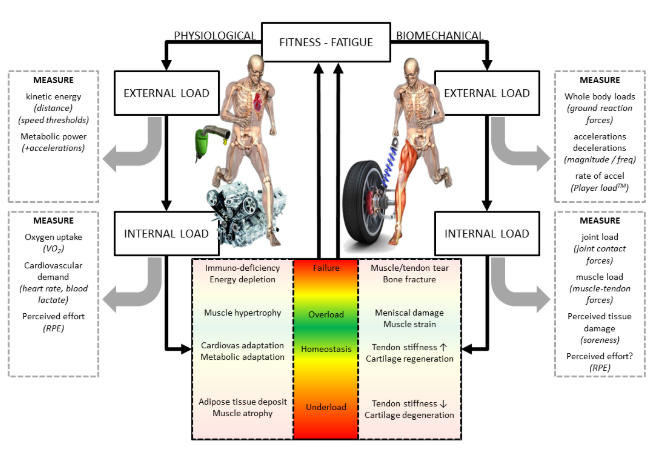Perhaps you, like many members of our ISPGR community, have been engaged in the development and evaluation of interventions to improve postural balance and ambulation? Most likely, this was for frail members of our society who have an increased risk of falling due to reduced muscle strength/power, or in patient populations who suffer from musculoskeletal disease or degeneration? In that case it is unlikely that you often venture into the sports medicine literature, let alone literature that establishes a theoretical framework for sport scientists who are engaged in the daily monitoring of elite athletes. In this blog, I would like to offer some creative ideas on how to evaluate physiological adaptations from a strength training programme for the frail elderly person, or how to monitor neuromechanical adaptations from ballroom dancing classes for the baby boomers.
In our recent perspective paper in Sports Medicine, we reviewed some of the sports science and sports medical literature on the recent developments of player load monitoring. The scientific field of player load monitoring has grown rapidly, and we believed that there was a lack of theoretical framework to justify the daily monitoring of a vast amount of variables in sports environments, ranging from subjective ratings of perceived exertion to a host of complicated derivatives from GPS-based position tracking. Historically, this has been the domain of exercise physiologists, who have gained extensive knowledge on physiological processes and the effects of different types of training regimes. Very few biomechanists have looked into this, and the knowledge on so-called ‘mechanobiological’ adaptations from training and exercise is still very limited. In order to address this important knowledge gap, we developed a theoretical framework that firstly separates a biomechanical load-adaptation pathway from the physiological load-adaptation pathway (see Figure). Secondly, the framework helps to identify observations that are associated with the external load (how is the body moving through and interacting with its environment), and observations that represent internal load (what is the stress on the internal structures and systems). The availability (and affordability) of wearable sensor technologies has made it possible to monitor external load more easily. Monitoring of the internal load and of the adaptations that are constantly taking place as a consequence of those loads, however, remain a huge challenge. For example, whilst sports scientists embrace the concept of supercompensation to explain the progressive physiological benefits from training and exercise, there are few experimental observations available that allow one to monitor this wonderful phenomenon actually taking place. Therefore, our perspective paper also addresses the practical implications and to some extent the pitfalls around measuring loads and adaptation outside a laboratory, some of which may well apply to other contexts than elite athlete monitoring.

Figure: A theoretical framework that separates a physiological load-adaptation pathway (left) from a biomechanical load-adaptation pathway (right). Measures that are indicative of what the body is doing (external load) are also separated from measures that represent the internal consequences to our body (internal load). Eventually, this internal load will cause adaptations which can be associated to each of these pathways, even if not exclusively so.
We hope that our perspective paper will assist the ISPGR community to consider using established methodologies from sports and exercise contexts into more clinical applications. For example, technologies developed by (and for) sports science could be used to evaluate physical loads due to therapeutic interventions. Or, established ratings of perceived effort multiplied by session time, may well be a useful tool in exercise programmes for the elderly or patient populations. Finally, we hope that the complex systems approaches to evaluate intricate interactions between various types of loads and load-adaptation pathways, could provide members of the ISPGR community with new ideas to better interrogate the multifactorial responses to multi-component exercise programmes within their clinical trials.
Publication
Vanrenterghem, J., Nedergaard, N.J., Robinson, M.A., Drust, B. (2017) Training load monitoring in team sports : A novel framework separating physiological and biomechanical load-adaptation pathways. Sports Medicine, Published Online First.
About the Author

Jos Vanrenterghem
Associate Professor in the Department of Rehabilitation Sciences, KU Leuven, Belgium
Jos Vanrenterghem is Associate Professor in the Department of Rehabilitation Sciences at KU Leuven in Belgium. His research focuses on the advancement of data analysis techniques in biomechanics and on the interplay between neuromuscular control strategies and musculoskeletal loading mechanisms.
Copyright
© 2018 by the author. Except as otherwise noted, the ISPGR blog, including its text and figures, is licensed under a Creative Commons Attribution-ShareAlike 4.0 International License. To view a copy of this license, visit https://creativecommons.org/licenses/by-sa/4.0/legalcode.
ISPGR blog (ISSN 2561-4703)
Are you interested in writing a blog post for the ISPGR website? If so, please email the ISGPR Secretariat with the following information:
- First and Last Name
- Institution/Affiliation
- Paper you will be referencing
